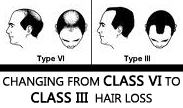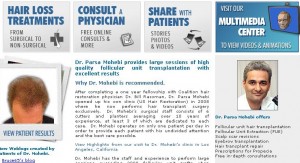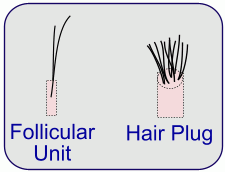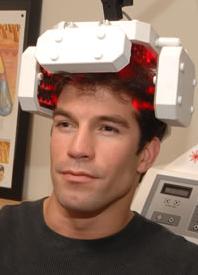Posts Tagged ‘hair restoration’
Tuesday, December 14th, 2010
Q:
I am a previous hair transplant patient who has class VI hair loss. I had previous procedures done to get some thin hair in the front and top. I am keeping my hair very short on the back and my primary goal was to camouflage the scar in the back of my head from previous hair transplants. So far, I have achieved this by simply growing my hair longer, and covered the rest of my scalp with Toppik-like products.

Cosmetically, the hair restoration was successful, but constant usage of this kind of product is a bit messy and annoying. Because of this, I have completely shaved my head and decided to try a different route. With the help of tattooing, I was going to go for a shaved head look. Unfortunately though, the scar is a show-stopper and I need to consider all of my options.
What I would consider to be a successful result is: short hair completely covering my head (even if only relatively light density) combined with tattooing and a self-tanner to reduce contrast. I am not “greedy” about the sides at the front, and will accept a 3 or 3A pattern. Is this possible in my case, though?
A:
It is good to hear that you are not striving for high density and that you are realistic about the final appearance of your hair. Being a class VI with limited donor hair, should leave options open to create light density in your large balding area, but obtaining more density would be extremely difficult if not impossible due to your insufficient donor hair. You should know your priorities and how many surgeries you are committed to have in order to achieve your desired look.
- If you only need to revise the scar and have trichophytic closure done to minimize the visibility of your scar, one surgery is adequate. Double edged trichophytic closure is a new technique that can improve the appearance of the scar tremendosly.
- If you are attempting to achieve higher density as well as scar revision, you may need several hair transplant procedures (depending on your donor amount available).
Your donor hair can be easily evaluated and options can be given to you for about what to be expected through attending a consultation with an experienced hair transplant doctor.
Tags: Donor Scar Hair Transplants, Donor Scar Revisions, Double Edged trichophytic Closure, FUT Hair Transplants, hair restoration, Hair Restoration Donor Scar, hair transplant donor scar, hair transplant scar revision
Posted in donor scar, hair transplant, Hair Transplant Procedure, hair transplant repair, men hair restoration | No Comments »
Tuesday, July 27th, 2010
Hair Transplant Surgeon Dr. Parsa Mohebi of Los Angeles, California was just approved for recommendation on well known website, the Hair Transplant Network, one of the largest online site that support hair loss patients. Dr. Mohebi has hair transplant offices in LA, Beverly Hills, Orange County with consultation offices in San Diego and San Francisco.
 California Hair Transplant Surgeon, Dr. Mohebi Hair Transplant Network has truly changed the industry of hair restoration because of its viewer participation and their high demands from its members who participate on the Hair Transplant Network along with the participating physicians. All participating members of this site have such high expectations and constantly demand superior quality results, only physicians with a solid reputation and proven results are approved for recommendation through their lengthy and meticulous evaluation and assessment of the hair transplant surgeons.
Over the last two years, the hair restoration forum and participating community on HairTransplantNetwork.com have had the chance to review Dr. Mohebi, his technique, and corresponding results from his patients to determine his recommendations. Following the lengthy and worthwhile examination process, we are now happy to say that Dr. Mohebi is among the few qualified hair transplant doctors to be recommended by the renowned Hair Transplant Network.
We are hoping that US Hair Restoration and its medical director Dr. Parsa Mohebi can continue educating hair loss patients about hair loss treatment and hair restoration surgeries that are available to them. It made it easier for a larger group of hair loss patients to be able to see Dr. Mohebi’s outstanding hair transplant results. Please feel free to check out some of our patient results and physician comments on this site at anytime and do not hesitate to ask questions on the forum if you have any.
Thank you all for your support!!
Tags: beverly hills, hair restoration, Hair Restoration Forum, Hair Transplant Blog, hair transplant forum, hair transplant network, Hair Transplant Physicians, Hair Transplant Recommendation, hair transplants, HTN.com, Recommended Physicians for Hair Transplants
Posted in Beverly Hills hair transplant, California hair transplant, hair transplant, Los Angeles Hair Transplant, Orange County hair transplant | No Comments »
Tuesday, January 26th, 2010

Q:
About 18 years ago, I underwent a hair restoration procedure with primitive technology. Nowadays, I’m very reluctant to ever do such a thing again. Since I had the transplant, I’ve been wearing a hair piece, which I don’t really like to do. I wonder: is it possible for my hair to ever look the way it did in my twenties? And, also, what if I don’t have enough donor hair, can I still get a hair transplant? If I don’t have enough donor hair, body hair is possible, right?
Also, I’m an algebra teacher, anyway this can be afforded on a salary like mine?
Sincerely,
-
A:
I appreciated the email. Here are my answers to your questions, in chronological order.
1. Most of the time, it can be corrected. A lot of our patients actually have needed repair hair transplants. Their situation was very similar to yours in that they had plugs or micro-graft surgeries.
2. Whether your donor hair is sufficient, I don’t know. I have to examine you for that. A good majority of people have enough hair to cover up a hair plug procedure. Some men have so much donor hair that they can even cover up other areas of hair loss.
3. It is plausible to use body hair, but it is much better to use head hair. If you’re in a situation in which you have virtually no scalp hair, and also high-quality body hair, you could be a good candidate for a body hair to head procedure.
4. I can’t tell you if your hair transplant surgery will be affordable right now. Only after I evaluate you. It’ll all be based on the number of grafts that you require. We offer discounted rates to qualified candidates on our standby program.
5. Make sure to attach photos of yourself and email them to me. The photos we need of your head are from the front, left and right sides, top and back. Make sure to also include a picture of the hair plugged areas of your head so I can take a better look at it.
After taking a look at your head shots, I’ll have a phone consultation with you and talk about the options that are open to you. It’s also a time where I can reply to all your questions.
Tags: donor hair, hair plug, hair restoration, hair restoration procedure, hair restoration surgery, hair transplant, hair transplant surgery, old hair plug, plug, repair hair plug
Posted in hair transplant, men hair restoration | No Comments »
Friday, January 15th, 2010

Not too long ago, consumer columnist David Lazarus, in a Los Angeles Times story, mentioned he had visited an open house at a hair transplant office and, to his surprise, saw that there were a lot of men who showed up. For him, it was unexpected. Lazarus said he had a conversation with the owner of the hair transplant center and learned that, in this fragile economy, a lot of men who are shopping for a hair transplant are thinking that it will better their job opportunities by having a full head of hair.
According to a CNN report, findings have shown that people who are better looking, or are slim (vs. fat), or who are of a younger age tend to have better success in the nation’s economy. These “lookers” bring in more money, have a better chance of moving up in the company, and tend to be treated more graciously. Albeit the results of this study may be a bit disturbing, it may be a somewhat accurate reflection of our society.
When we take into account these conclusions, it ought to come as no surprise that there are balding men in America who really hold fast to the idea that they can boost their chances of landing a job by sporting a full head of hair. It might just end up being a mental edge, or a self-esteem enhancer, for these adult males to give a good impression during their interviews.
All things considered, in my humble view, the crucial aspect of a job interview is a how a potential employee presents himself to his interviewer. The responses she gives, her demeanor, attitude about previous employers, and overall impression.
But, these days, some men believe it wouldn’t decrease their chances to have a full head of hair. In addition, due to the slumping economy, a hair transplant cost is at an all-time low for high-quality hair restorations. If there ever was a time to get a hair transplant for those who, under different circumstances wouldn’t get one, now is the time.
Tags: balding men, hair loss, hair loss and job prospects, hair restoration, hair transplant, job prospects, men hair loss
Posted in Bakersfield hair transplant, California hair transplant, hair transplant, men hair restoration, Newport Beach hair transplant, Orange County hair transplant | No Comments »
Tuesday, January 12th, 2010

In the past 30 years, alternate types of therapy for enhancing wound repair have been mentioned. For this entry, I wanted to talk about the cutting-edge areas of stem cell therapy and gene therapy in wound healing. When it comes to gene therapy, it was first put into practice for treating congenital defects. Now, it is a fresh alternative for affecting wound repair. To speed up the process of wound closure, genes encoded for growth factors or cytokines revealed the greatest potential.
Most gene delivery systems have roots in viral transfection, naked DNA application, high pressure injection, or liposomal vectors. Embryonic and adult stem cells posses an extended self-renewal ability with the capacity to differentiate into various tissue types. Different types of sources, such as bone marrow, peripheral blood, umbilical cord blood, adipose tissue, skin and hair follicles, have been used to separate stem cells to speed up the healing response of acute and chronic wounds.
Not too long ago, the grouping of gene and stem cell therapy has come to the forefront as a potential option to care for chronic and acute wounds.
For potential hair transplant patients, this breaking development about gene and stem cell therapy in hair restoration is fantastic news because a rapid healing from stitches in the donor area would make for a much quicker and painless procedure. There are all kinds of different types of hair loss, but, if a hair loss sufferer undergoes a hair transplant, it would be imperative that his stitches would heal quickly.
Source information was provided by the following authors: Branski LK, Gauglitz GG, Herndon DN, Jeschke MG.
Department of Surgery, The University of Texas Medical Branch and Shriners Hospitals for Children, Galveston, TX 77550, United States.
Tags: donor scar, gene therapy, hair loss, hair restoration, hair transplant, stem cell therapy, wound healing, wound treatment, wounds
Posted in Bakersfield hair transplant, California hair transplant, hair transplant, men hair restoration, Newport Beach hair transplant, Orange County hair transplant | No Comments »
Saturday, December 19th, 2009

Hair transplant surgery has evolved in the last 10 years thanks to microscopic techniques and research which elucidated the mechanism of hair loss and hair restoration surgery. We now can transplant with maximum natural results. We also increased the number of grafts which could be safely removed and harvested during a single hair transplant procedure. Mega session hair transplants have been a very hot topic and an interesting idea for many people who have a large balding area that cannot simply be covered with anything less than 3000-4000 grafts.
At the offices of US Hair Restoration, we evaluate every patient for the quality of donor hair and scalp which will determine the number of grafts that could be safely harvested and transplanted in one surgery. Many people who are getting their first surgery can have over 3000 grafts. We have numbers of up to 5000 grafts, too.
Laser hair restoration is a pretty new concept and unfortunately we still do not have enough solid research published in peer reviewed journals documenting its effectiveness. There have been some results in smaller studies with some effect. However, I would rather wait on that until we have more research-proven documents in that regard.
You need to be evaluated for your donor potential and can consider surgery after that. US Hair Restoration has special hair transplant travel reimbursements for patients like you who have to fly from other cities. We also provide hotel and transportation to and from the hotel for anyone who has to commute more than 50 miles to get to our hair restoration center.
Tags: hair loss, hair restoration, hair transplant, hair transplant cost, hair transplant travel, hair transplant travel reimbursement, laser hair transplant, laser hair treatment
Posted in Bakersfield hair transplant, California hair transplant, hair transplant, men hair restoration, Newport Beach hair transplant, Orange County hair transplant | No Comments »
Saturday, November 14th, 2009

In the latest issue of the Journal of Internal Medicine, a new research study was published: “A Rare Complication: New Hair Growth Around Healing Wounds.” This study is related to Dr. Mohebi’s personal research at Johns Hopkins Medical Institute on gene therapy techniques and wound healing and how it affected the growth of mice hair.
The journal study was about a person who had hair growth surrounding a healing wound at Guangxi Medical University in Nanning, China.
The doctors involved in the study mention an incident in which hair growth occurred around a wound during the process of wound healing. Hair growth after wound healing is an atypical occurrence. This is the first time such an event had ever been recorded in scientific literature.
The doctors concluded that the wounds damaged the hair follicles and epidermis, but that it was possible for both to repair themselves if there was a suitable physical and chemical micro-environment. The doctors say that this new hypothesis may very well lead to new methods of managing hair loss, tissue engineering, and the regeneration of other organs.
At the laboratory of Johns Hopkins Medical Institute, and as part of my overall research, I did a major investigative study on hair growth as a byproduct of wound healing. On a few rats, after witnessing wound healing, to my delight, I found that some gene therapy techniques stimulated the hair growth.
My attention was on hair growth only and, coincidentally, our results matched other hair growth-wound healing studies, during 2005 to 2006. At the University of Pennsylvania, Dr. Cotsarelis, along with his contemporaries, first made public a study on the relationship between wound healing and hair growth through activation of the molecular pathway WNT.
Other similar studies have called attention to the fact that hair restoration through tissue engineering, hair multiplication, and gene therapy might one day happen and that we just may have a breakthrough a lot sooner than we expected all these years.
Parsa Mohebi, M.D.
Medical Director
US Hair Transplant
Tags: gene therapy, hair growth, hair loss, hair restoration, wound healing
Posted in California hair transplant, hair transplant, men hair restoration, women hair loss | No Comments »
Friday, October 30th, 2009

The field of hair growth and hair restoration has introduced a new player to its lineup: TRH (Thyrotropin-Releasing Hormone). It is likely TRH may turn out to be a heavy hitter in the fast-growing hair transplant industry.
Just recently, a new finding in hair elongation and the hair growth cycle was published in the Journal of the Federation of American Societies for Experimental Biology (The FASEB Journal). The research was conducted in Germany by Dr. Gaspar at the top-ranked University of L’beck, Department of Dermatology and Department of Internal Medicine.
It’s been shown that Thyrotropin-Releasing Hormone (TRH) is one of the crucial elements involved in the hair follicle growth cycle. Thyrotropin-Releasing Hormone is very closely situated to the hypothalamic-pituitary-thyroid axis. This axis stabilizes thyroid hormone synthesis.
Scientists have decided to study whether human hair follicle functions are also modulated by thyrotropin-releasing hormone, because it’s been found in human tissue. According to their findings, the researchers say that the epithelium of human scalp hair follicles expresses not only TRH receptors (TRH-R), but also TRH itself at the protein and gene level.
They found stimulation of organ-cultured hair growth with thyrotropin-releasing hormone stimulates hair follicle elongation, prolongs the hair growth cycle phase (anagen), and antagonizes its termination by TGF-beta2. It also increases proliferation and inhibits the apoptosis of hair matrix keratinocytes.
So, we can conclude from the study that thyrotropin-releasing hormone operates as a legitimate potent hair-growth stimulator. It’s proven to be an ideal discovery tool for identifying functions of thyrotropin-releasing hormone are hair follicles.
Tags: hair growth, hair growth stimulator, hair restoration, Thyrotropin-Releasing Hormone, TRH
Posted in hair loss medication, men hair restoration | No Comments »
Thursday, March 5th, 2009
Many hair restoration clinics can easily boast about their successful hair transplants but what about the ones that did not have optimal result? I received an email from a patient whom had a hair transplant at a different clinic. His hair never grew in the transplanted area even after having followed all the post op directions carefully. He also asks, Is there any other solutions to bring back my hair?
One of the biggest concerns for any patient who has hair restoration is the survival of transplanted hair. In some cases transplanted hair might never grow or experience suboptimal growth. These factors can be categorized into two major groups: 1) Technical Problems and 2) Patient Factor.
Hair Transplant Technical Problems
- Hair graft preparation and handling problems: Inexperienced technicians may actually manipulate hair grafts more than what the hair grafts can tolerate. This may lead to damage to the proliferated follicle cells during graft slivering, harvesting or implanting. In turn, the transplanted hair will not grow.
- Graft maintenance problems: From the moment the hair is removed from the body, hair follicles should be kept in a suitable physiological solution until the time they are placed in their new location. The solution must be kept between 4 degrees centigrade to slow the cell metabolism and prolong the longevity of the follicular cells.
- Complications during implantation phase: If sites are made too tight, technicians might manipulate the hair grafts physical attributes too much and affect the final potential of the hair cells growth.
Patient Factors
- In some rare occasions certain skin conditions can either restrict or stop transplanted hair from growing. The most common forms of skin conditions are alopecia areata (AA) and alopecia cicatricial (AC) as well as other medical conditions that may have already been present on or before the hair transplant procedure. This is why it is crucial to evaluate the hair and scalp by means of preoperative microscopic and macroscopic evaluation to rule out any condition that can affect transplanted hair growth. All hair transplant surgeons should raise these questions during their consultation especially if the patient has atypical hair loss or does not have any family history of similar hair loss conditions. If there is any doubt, it can easily be confirmed through scalp biopsy.
- After hair transplant care plays a very important role in the final results of any hair transplant procedure. Physical trauma to the newly transplanted hair may cause you to lose your newly transplanted hair. Other forms of hair trauma include pulling out or scratching newly transplanted hair or in psychological conditions like Trichotillomania in which they pull out their own hair.
It is best to review your results after one post surgery is completed by a good hair transplant surgeon. After reevaluation your hair transplant surgeon can tell you what may have caused your condition and maybe even treat the disorder that caused your less than desirable growth results.
We at our California hair restoration clinics perform several repair hair transplant surgery every month. Some of them are the result of old and some from recent but not perfect procedures.
Tags: hair restoration, hair transplant surgeon, unsuccessful hair transplat
Posted in men hair restoration, Uncategorized | No Comments »
|
|








